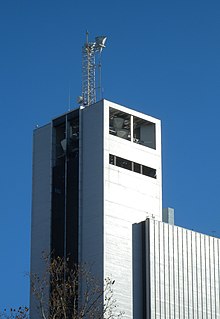 W
WAntenna diversity, also known as space diversity or spatial diversity, is any one of several wireless diversity schemes that uses two or more antennas to improve the quality and reliability of a wireless link. Often, especially in urban and indoor environments, there is no clear line-of-sight (LOS) between transmitter and receiver. Instead the signal is reflected along multiple paths before finally being received. Each of these bounces can introduce phase shifts, time delays, attenuations, and distortions that can destructively interfere with one another at the aperture of the receiving antenna.
 W
WAn antenna rotator is a device used to change the orientation, within the horizontal plane, of a directional antenna. Most antenna rotators have two parts, the rotator unit and the controller. The controller is normally placed near the equipment which the antenna is connected to, while the rotator is mounted on the antenna mast directly below the antenna.
 W
WBeam tilt is used in radio to aim the main lobe of the vertical plane radiation pattern of an antenna below the horizontal plane.
 W
WA candelabra or candelabrum is a candle holder with multiple arms.
 W
WA Duo LNB is a double low-noise block downconverter (LNB) developed by SES for the simultaneous reception of satellite television signals from both the Astra 23.5°E and Astra 19.2°E satellite positions.
 W
WIn telecommunication, the term front-to-back ratio can mean:The ratio of power gain between the front and rear of a directional antenna. Ratio of signal strength transmitted in a forward direction to that transmitted in a backward direction. For receiving antennas, the ratio of received-signal strength when the antenna is rotated 180°.
 W
WThe G5RV antenna is a dipole with a symmetric resonant feeder line, which serves as impedance matcher for a 50 Ω coax cable to the transceiver.
 W
WHeight above average terrain (HAAT), or effective height above average terrain (EHAAT), is the vertical position of an antenna site is above the surrounding landscape. HAAT is used extensively in FM radio and television, as it is more important than effective radiated power (ERP) in determining the range of broadcasts. For international coordination, it is officially measured in meters, even by the Federal Communications Commission in the United States, as Canada and Mexico have extensive border zones where stations can be received on either side of the international boundaries. Stations that want to increase above a certain HAAT must reduce their power accordingly, based on the maximum distance their station class is allowed to cover.
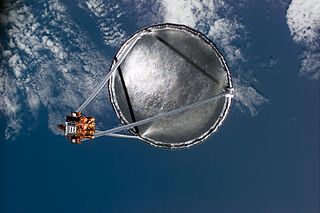 W
WThe Inflatable Antenna Experiment (IAE) was a NASA experiment that began on May 19, 1996, consisting of an inflatable antenna made of mylar which was launched from the Space Shuttle Endeavour during the 1996 STS-77 mission, in cooperation with the satellite Spartan-207.
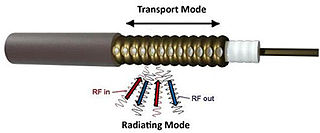 W
WA leaky feeder is a communications system used in underground mining and other tunnel environments. Manufacturers and cabling professionals use the term "radiating cable" as this implies that the cable is designed to radiate: something that coaxial cable is not generally supposed to do.
 W
WA low-noise block downconverter (LNB) is the receiving device mounted on satellite dishes used for satellite TV reception, which collects the radio waves from the dish and converts them to a signal which is sent through a cable to the receiver inside the building. Also called a low-noise block, low-noise converter (LNC), or even low-noise downconverter (LND), the device is sometimes inaccurately called a low-noise amplifier (LNA).
 W
WMagnetic current is, nominally, a current composed of fictitious moving magnetic monopoles. It has the dimensions of volts. The usual symbol for magnetic current is which is analogous to for electric current. Magnetic currents produce an electric field analogously to the production of a magnetic field by electric currents. Magnetic current density, which has the units of V/m2, is usually represented by the symbols and . The superscripts indicate total and impressed magnetic current density. The impressed currents are the energy sources. In many useful cases, a distribution of electric charge can be mathematically replaced by an equivalent distribution of magnetic current. This artifice can be used to simplify some electromagnetic field problems. It is possible to use both electric current densities and magnetic current densities in the same analysis.
 W
WIn a radio antenna's radiation pattern, the main lobe, or main beam, is the lobe containing the higher power. This is the lobe that exhibits the greater field strength.
 W
WThe near field and far field are regions of the electromagnetic field (EM) around an object, such as a transmitting antenna, or the result of radiation scattering off an object. Non-radiative near-field behaviors dominate close to the antenna or scattering object, while electromagnetic radiation far-field behaviors dominate at greater distances.
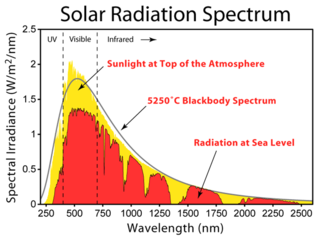 W
WAn optical rectenna is a rectenna that works with visible or infrared light. A rectenna is a circuit containing an antenna and a diode, which turns electromagnetic waves into direct current electricity. While rectennas have long been used for radio waves or microwaves, an optical rectenna would operate the same way but with infrared or visible light, turning it into electricity.
 W
WAn orthomode transducer (OMT) is a waveguide component. It is commonly referred to as a polarisation duplexer. Orthomode transducers serve either to combine or to separate two orthogonally polarized microwave signal paths. One of the paths forms the uplink, which is transmitted over the same waveguide as the received signal path, or downlink path. Such a device may be part of a VSAT antenna feed or a terrestrial microwave radio feed; for example, OMTs are often used with a feed horn to isolate orthogonal polarizations of a signal and to transfer transmit and receive signals to different ports.
 W
WIn antenna design theory, the phase center is the point from which the electromagnetic radiation spreads spherically outward, with the phase of the signal being equal at any point on the sphere. Apparent phase center is used to describe the phase center in a limited section of the radiation pattern.
 W
WA rectenna is a special type of receiving antenna that is used for converting electromagnetic energy into direct current (DC) electricity. They are used in wireless power transmission systems that transmit power by radio waves. A simple rectenna element consists of a dipole antenna with an RF diode connected across the dipole elements. The diode rectifies the AC induced in the antenna by the microwaves, to produce DC power, which powers a load connected across the diode. Schottky diodes are usually used because they have the lowest voltage drop and highest speed and therefore have the lowest power losses due to conduction and switching. Large rectennas consist of an array of many power receiving elements such as dipole antennas.
 W
WIn antenna engineering, side lobes or sidelobes are the lobes of the far field radiation pattern of an antenna or other radiation source, that are not the main lobe.
 W
WThe six-rays model is applied in an urban or indoor environment where a radio signal transmitted will encounter some objects that produce reflected, refracted or scattered copies of the transmitted signal. These are called multipath signal components, they are attenuated, delayed and shifted from the original signal (LOS) due to a finite number of reflectors with known location and dielectric properties, LOS and multipath signal are summed at the receiver.
 W
WIn radio electronics, especially radar terminology, slant range is the line-of-sight distance along a slant direction between two points which are not at the same level relative to a specific datum.
 W
WThe Belling-Lee connector is commonly used in Europe and Australia to connect coaxial cables with each other and with terrestrial VHF/UHF roof antennas, antenna signal amplifiers, CATV distribution equipment, TV sets, and FM and DAB radio receivers. In these countries, it is known colloquially as a PAL antenna connector, IEC antenna connector, or simply as a TV aerial plug. It is one of the oldest coaxial connectors still commonly used in consumer devices. For television signals, the convention is that the source has a male connector and the receptor has a female connector. For FM radio signals, the convention is that the source has a female connector and the receptor has a male connector. This is more or less universally adopted with TV signals, while it's not uncommon for FM radio receivers to deviate from this, especially FM radio receivers from companies not based in the areas that use this kind of connector.
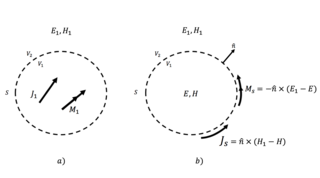 W
WIn electromagnetism, surface equivalence principle or surface equivalence theorem relates an arbitrary current distribution within an imaginary closed surface with an equivalent source on the surface. It is also known as field equivalence principle, Huygens' equivalence principle or simply as the equivalence principle. Being a more rigorous reformulation of the Huygens–Fresnel principle, it is often used to simplify the analysis of radiating structures such as antennas.